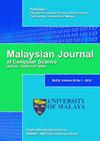DETECTION OF BIO ELEMENTS PRESENT IN HUMAN BIOLOGICAL TISSUE-TOOTH AND ITS USAGE FOR ELEMENT BIOMETRIC AUTHENTICATION
IF 1.2
4区 计算机科学
Q4 COMPUTER SCIENCE, ARTIFICIAL INTELLIGENCE
引用次数: 1
Abstract
Biometric authentication system uses some technique that measures the physical and biological characteristics of human to identify individuals and thus provide security to a system against fraud or intrusion. Common biometric authentication processes are vulnerable and possibility for imitation. Teeth are an important biological entity that plays a major role in forensic research to identify an individual whom cannot be identified visually. There are different algorithms used in biometric authentication. This paper proposes a unique method to recognize the human teeth by using a combination of Discrete Fourier Transform (DFT) and Discrete Cosine Transform (DCT) to extract significant features and an improved version of Binary Particle Swarm Optimization (BPSO) for feature selection is employed to search the feature vector space in order to obtain optimal feature subset to increase the performance rate. A combination of image pre-processing techniques like background removal, gamma intensity correction and Laplacian of Gaussian (LoG) filter are used to help in correct feature extraction. Using the shift invariance property of DFT, a circular feature extraction technique and the energy compaction property of DCT, a circular sector feature extraction method is presented. Experimental results on IvisionLab/dental-image standard database are shown which exhibit promising performance of the teeth recognition system.人体生物组织中生物元素的检测及其在元素生物认证中的应用
生物识别认证系统使用一些测量人类的物理和生物特征的技术来识别个人,从而为系统提供防止欺诈或入侵的安全性。常见的生物特征身份验证过程易受攻击,有可能被模仿。牙齿是一种重要的生物实体,在法医学研究中发挥着重要作用,以识别无法通过视觉识别的个体。生物特征认证中使用了不同的算法。本文提出了一种独特的识别人类牙齿的方法,将离散傅立叶变换(DFT)和离散余弦变换(DCT)相结合来提取重要特征,并采用改进的二进制粒子群优化算法(BPSO)对特征向量空间进行搜索,以获得最佳特征子集,从而提高性能速度图像预处理技术(如背景去除、伽马强度校正和拉普拉斯高斯(LoG)滤波器)的组合用于帮助正确的特征提取。利用DFT的平移不变性、圆形特征提取技术和DCT的能量压缩特性,提出了一种圆形扇区特征提取方法。在IvisionLab/牙科图像标准数据库上的实验结果表明,该系统具有良好的识别性能。
本文章由计算机程序翻译,如有差异,请以英文原文为准。
求助全文
约1分钟内获得全文
求助全文
来源期刊

Malaysian Journal of Computer Science
COMPUTER SCIENCE, ARTIFICIAL INTELLIGENCE-COMPUTER SCIENCE, THEORY & METHODS
CiteScore
2.20
自引率
33.30%
发文量
35
审稿时长
7.5 months
期刊介绍:
The Malaysian Journal of Computer Science (ISSN 0127-9084) is published four times a year in January, April, July and October by the Faculty of Computer Science and Information Technology, University of Malaya, since 1985. Over the years, the journal has gained popularity and the number of paper submissions has increased steadily. The rigorous reviews from the referees have helped in ensuring that the high standard of the journal is maintained. The objectives are to promote exchange of information and knowledge in research work, new inventions/developments of Computer Science and on the use of Information Technology towards the structuring of an information-rich society and to assist the academic staff from local and foreign universities, business and industrial sectors, government departments and academic institutions on publishing research results and studies in Computer Science and Information Technology through a scholarly publication. The journal is being indexed and abstracted by Clarivate Analytics'' Web of Science and Elsevier''s Scopus
 求助内容:
求助内容: 应助结果提醒方式:
应助结果提醒方式:


